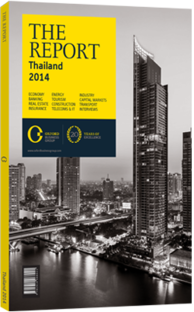Supalai: Property development
The Company
Established in 1989 and listed in the Stock Exchange of Thailand in 1993, Supalai (SPALI) is the sixth-largest property developer in Thailand in terms of presales (value of residential bookings). In 2013, 98% of SPALI’s BT12.6bn ($412m) revenue came from transfers of residential projects while the rest was from rental and services. In addition to Bangkok, SPALI is present in other major provinces of Thailand. In 2012 and 2013, 25% of its annual presales came from outside the Bangkok Metropolitan Region. SPALI’s main advantage over its peers has been cost leadership as evidenced in its superior net profit margin. Over the past five years, its net profit margin has been in the range of 20% to 26%, while 10-15% has been the norm for the industry thanks to highly efficient construction and development processes and low-cost and effective marketing activities. Efficient construction and development processes include in-house design and construction management, self-purchase of construction materials, and optimising sellable area to the total construction area. The sellable-area-to-construction-area ratio for SPALI’s condominium projects is usually in the neighbourhood of 65-70% (vs. peers’ at 55-65%) because SPALI focuses on building larger condominium rooms.
Development Strategy
SPALI’s key competitive strength still lies with its stringent cost control and production efficiency. Thus, the company is expected to continue utilising that advantage to offer cheaper residential units with high quality to consumers. Anticipating that land prices will rise by more than 4% p.a. over the next few years, SPALI accumulated land quite aggressively in 2013. The company targets to maintain its residential gross profit margin above 40%, the highest level in the industry. It plans to launch 26 new projects worth a combined BT33bn ($1bn) in 2014, up from BT17.7bn ($578m) in 2013.
SPALI aims to boost upcountry presales from 25% to 27% of the total in 2014. The emphasis will be on single detached houses and townhouses, as presales of low-rise properties in provincial markets are still going well, while presales of condominium projects upcountry began to disappoint in 2013; local people in the provinces still prefer the bigger space and land ownership offered by low-rise real estate. Ten low-rise projects (BT8.2bn, $268m) are planned to be launched in the provincial markets while only one condo (BT1.7bn, $55.6m) will be launched outside Bangkok in Chiang Mai in 2014. Two new provinces will be added to the portfolio, including Ubon Ratchathani and Nakorn Ratchasima. Nevertheless, the management suggests that presales of condominium projects close to existing and future mass transit train stations in Bangkok continue to be healthy.
SPALI’s focus for 2014-15 is on completion of quality residential units and timely delivery rather than aggressive presales generation thanks to its hefty backlog of BT39.2bn ($1.28bn) (sales bookings waiting to be transferred), which will be realised as revenue throughout the 2014-17 period.
We forecast that SPALI’s residential transfers will rise by 56.9% in 2014 and much more labour will be needed for construction. As a result, SPALI is considering the use of prefabrication technology. Precast materials (i.e., walls, floors and facades) could substitute for much of the work done by unskilled labour and speed up the construction process substantially, especially for low-rise residential units. Application of precast materials by other developers has shortened the construction period for a low-rise housing unit from six to eight months to three to four months.
The year 2014 is expected to be the best for SPALI, in terms of earnings growth, and the momentum is likely to continue into 2015 when a BT14.4bn ($470.8m) backlog is expected to be realised. We expect SPALI’s earnings to grow at the rate of 34.6% CAGR in 2014-15. The company is committed to its 40-50% dividend payout policy while trying to pay at least the same absolute amount of dividend as the year prior. It plans to keep its gearing ratio below 1x.
You have reached the limit of premium articles you can view for free.
Choose from the options below to purchase print or digital editions of our Reports. You can also purchase a website subscription giving you unlimited access to all of our Reports online for 12 months.
If you have already purchased this Report or have a website subscription, please login to continue.

